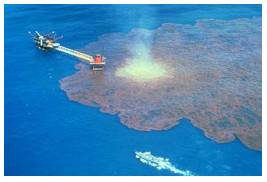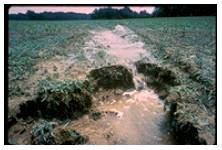| Water Pollution | |
|
It has been known for about 30 years that acids generated by industrial and car emissions in northwestern Europe are carried by the prevailing winds to Scandinavia where they are deposited in rain and snow. As a result of this continuous process it has been estimated that some 18,000 lakes in Sweden are now so acidic that they will no longer support game fish or other sensitive aquatic organisms. Many people believe that water pollution comes from a pipe, such as from factories and sewage treatment plants or from oil spills at sea and, whilst this is true, a large amount of water pollution is also caused through "surface water runoff". This type of pollution is usually called diffuse or "non-point source" pollution because it comes from a wide variety of sources, not from a single discharge pipe. |
The IXTOC I exploratory well blow out in the Bay of Campeche, Mexico, caused 140 million gallons of oil to spill into the bay, making this the largest oil spill in history, second only to the oil released deliberately during the Gulf War. |
| Diffuse Water Pollution
Agricultural run off may occur when fields are poorly designed or maintained |
When it rains, water washes over driveways, roofs, agricultural lands, streets, lawns, and building sites, picking up soil, rubbish and toxic substances. The amount of pollution carried by rainwater, snowmelt and irrigation water flowing into streams and lakes, and through the soil into groundwater is generally much larger than pollution from industry. It causes damage to fish, wildlife and their habitat; damages drinking water supplies, and promotes excessive weed growth. Pollutants are varied and depend on source. Agricultural run-off for example tends to contain nutrients, sediment, animal wastes, salts, and pesticides. |

